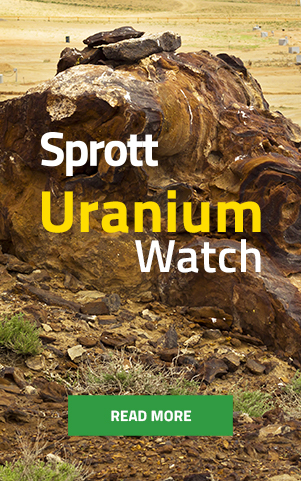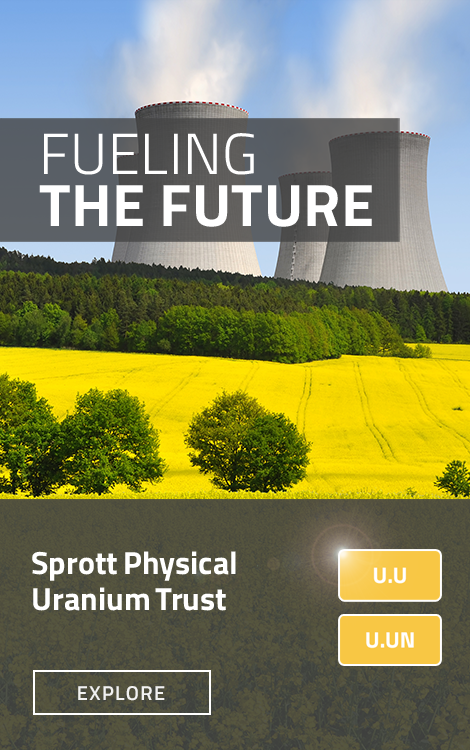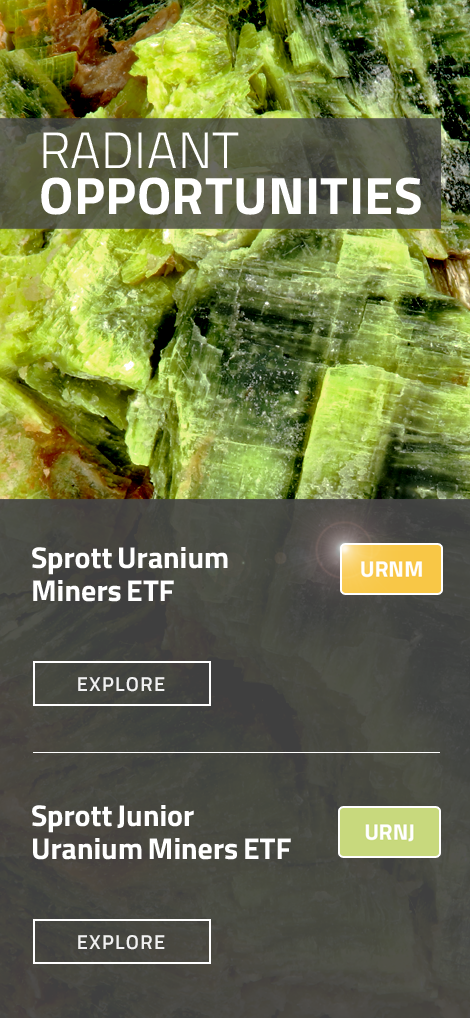A new uranium bull market is underway. Energy security and decarbonization are taking center stage globally, igniting a fresh and more rational look at the benefits of nuclear power. Ed Coyne, Senior Managing Director at Sprott, joins Tim Rotolo, co-creator of the North Shore Global Uranium Mining Index (URNMX), to explain how the Index is constructed to provide exposure to the key components of the uranium mining industry.
Video Transcript
Ed Coyne: Hello, my name's Ed Coyne, Senior Managing Director at Sprott Asset Management. Sprott's a dynamic firm focusing on precious metals and real assets. With over four decades of experience and over $23 billion in assets, we are one of the largest firms in the precious metals real asset universe. Today, I want to talk specifically about clean energy. I want to talk about uranium and its potential role in a carbon-neutral future. For that, I've asked Tim Rotolo from North Shore Indices to join me for this conversation. Tim, thanks for being part of it.
Tim Rotolo: Thanks, Ed. Good to see you.
Ed Coyne: I think we should dive right into the main crux of this, which is what was the spark or interest level for you in creating an index targeting uranium?
Tim Rotolo: When we looked at the marketplace in 2017 and 2018, there wasn't a natural way for retail and generalist investors to play the uranium market. There was one index out there. We didn't think it was a great option. It owned a lot of non-pure play stocks like construction companies and things that wouldn't give investors direct access to the theme. We set about creating an index that was a one-stop-shop for physical uranium and equities related to uranium mining. That was the genesis of the North Shore Global Uranium Mining Index (URNMX).
Ed Coyne: When you created the Index, what was the initial interest? Was there anybody paying attention when the Index first came out?
Tim Rotolo: Yes, there was a small cohort of retail investors, many of whom were on Twitter, lamenting that there wasn't a better option. So we looked at a couple of different potential situations, a closed-end fund, a pure physical vehicle, and the feedback that we got was that people wanted exposure to both physical uranium and the mining equities in one vehicle. That's how we got to this roughly 80/20 split of the Index today, to 80% equities and 20% physical.
Ed Coyne: Let's talk about that for a minute because I think the physical market is where many investors start. How do I get exposure to this as a commodity? How do I think about that space? You've solved that solution by creating an all-encompassing Index that gives you exposure to both, 80% equities and 20% physical. What was the reasoning behind the split? What was your thinking there?
Tim Rotolo: Before Sprott took over Uranium Participation Corporation (UPC), the options were not great in the physical uranium space. They were corporations that could trade at big discounts, and you're waiting for management to try and unlock that discount or close that discount. Sprott has dramatically improved the ability for investors to access physical uranium now. But it did feel like, from a portfolio construction standpoint, it's a very diverse universe of stocks, many of which are smaller-cap and very volatile. The way I looked at it — and this is similar to how I think Sprott thinks about the world — is you have this spectrum of investment opportunities in most commodities, starting with physical being the lowest volatility and direct way to play a thesis on rising prices. Then you generally have producers or a more diversified vehicle like an ETF. Hopefully, there is one for most of the sectors today. Then you have the individual equities. Again, you have a spectrum, from producers to exploration and kind of the full risk spectrum there.
Tim Rotolo: I wanted to create a single investment option that gave people exposure to as much of that uranium spectrum as possible and acknowledging that there will be times when physical uranium is doing quite well and provides a lower volatility option. We used aspects of modern portfolio theory to create this more diversified return stream, given that physical uranium provides a lower volatility option. So when times are good, you're not underperforming physical uranium because you have exposure to smaller-cap exploration stocks and developers, which have a lot of volatility and torque to the upside. But in times of more volatility and downside, physical uranium actually provides some protection and ballast is how I think about it. You have this yin and yang, and they balance out very nicely over time. You get a similar upside but not as much downside risk as owning the uranium equities.
Ed Coyne: It sounds to me like you cracked the code because at Sprott, with over $23 billion in precious metals, we also looked at the world starting with the physical market first, whether it's our gold trust or our silver trust, and you just mentioned, our uranium trust to the equities. We've got our active mutual funds in the gold mining space. We've got factor-based ETFs. With this acquisition, we have the Sprott Uranium Miners ETF, URNM. I think this ETF, for the typical investor, may provide a one-stop solution to the uranium space. It's very dynamic. We're excited to be part of this and to offer uranium investments to our shareholder base.
Ed Coyne: Talk about that from an investment standpoint as an investor considering uranium as part of their portfolio. This is not a typical allocation that most investors think about on day one. What should they be expecting? We've seen some volatility, but we've also seen tremendous upswings and downswings over the last year and a half. What should be an appropriate expectation for a client as they start considering uranium as part of their portfolio?
Tim Rotolo: You have to start with your conviction level in the thesis. Why are you involved? Is it the long-term clean energy story? Is it a more secular supply shortage theory? Today, we have a couple of different theses within the uranium sector. You have nuclear energy taking off and becoming a much larger part of global decarbonization efforts. I think you need to start here, and the way we've always thought about it is, for us to be right about the macro thesis, physical prices have to go up. Then the question is, do you want exposure directly just to physical uranium, or do you have a higher risk tolerance and want exposure to uranium equities?
I think it's a question of where does this fit? Do you have a 10, 15 or 20% allocation to commodities today? I think uranium is a unique diversifier within the commodity space because it doesn't trade in the same way with the U.S. dollar or gold does with real rates. It's not necessarily an industrial commodity the way silver is. You can look at a uranium allocation as a uniquely opportunistic but now multi-year theme in your portfolio. Much of it will come down to your risk tolerance and whether the allocation should be a 2% position, a 5% position or a 10% position.
Going back just a couple of years, I would've said this is a much more speculative thesis around there being a uranium supply shortage. That story is here today. And now you have the added benefit of it being a much larger part of the global decarbonization effort around nuclear power. The demand story is here; the supply story is here. Investors can have more comfort with holding a long-term position in uranium and looking at it as a diversifier against equities and their traditional commodity allocations.
Ed Coyne: I love to think of it that way. As you get more and more countries talking about 2035 to 2050 of when will we be carbon neutral, the landscape for nuclear as part of the solution, the baseload solution as part of the green energy solution, seems to be here. We believe it will continue to expand and grow for many years.
Tim Rotolo: I would agree with that. And I think if we want to think about it, these are still early innings for this multi-year secular story around uranium and nuclear power. I think what's been so interesting is how this thesis has evolved and just become increasingly stronger. Many things two or three years ago that we never thought were possible two or three years ago, such as Diablo Canyon in California and the U.S. government putting $6 billion behind its nuclear power plants, were things that people literally wrote off as never possible. There has been tremendous support from people like Bill Gurley, Josh Wolfe, Elon Musk and Marc Andreessen around nuclear power.
Ed Coyne: Powerful names.
Tim Rotolo: These are incredibly powerful people who can amplify a message. For the first time, it feels like nuclear power is being viewed in a very rational light. It's no longer being viewed through the fear-mongering lens that the media has tended to use. I think we're at such a different point in the life cycle of the uranium investment opportunity. It's a really exciting time. And again, the fact that investing in uranium continues to be somewhat uncorrelated to other strategies is just an added benefit.
Ed Coyne: Low correlation is key. I like to say uranium's gone from a trade to an investment. It's now something you can be thinking about as part of your portfolio and being additive over multiple cycles, given that the entire landscape has expanded over the last couple of years.
Tim Rotolo: I definitely agree with that.
Ed Coyne: We're excited about the partnership. We're thrilled to have you be part of this conversation. And for those investors out there that want to learn more about Sprott, we encourage you to visit us at Sprott.com, where you can download a prospectus, fact sheets, white papers and learn more about how uranium could become part of your portfolio. Once again, my name's Ed Coyne, Senior Managing Director of Sprott Asset Management. Thank you.




